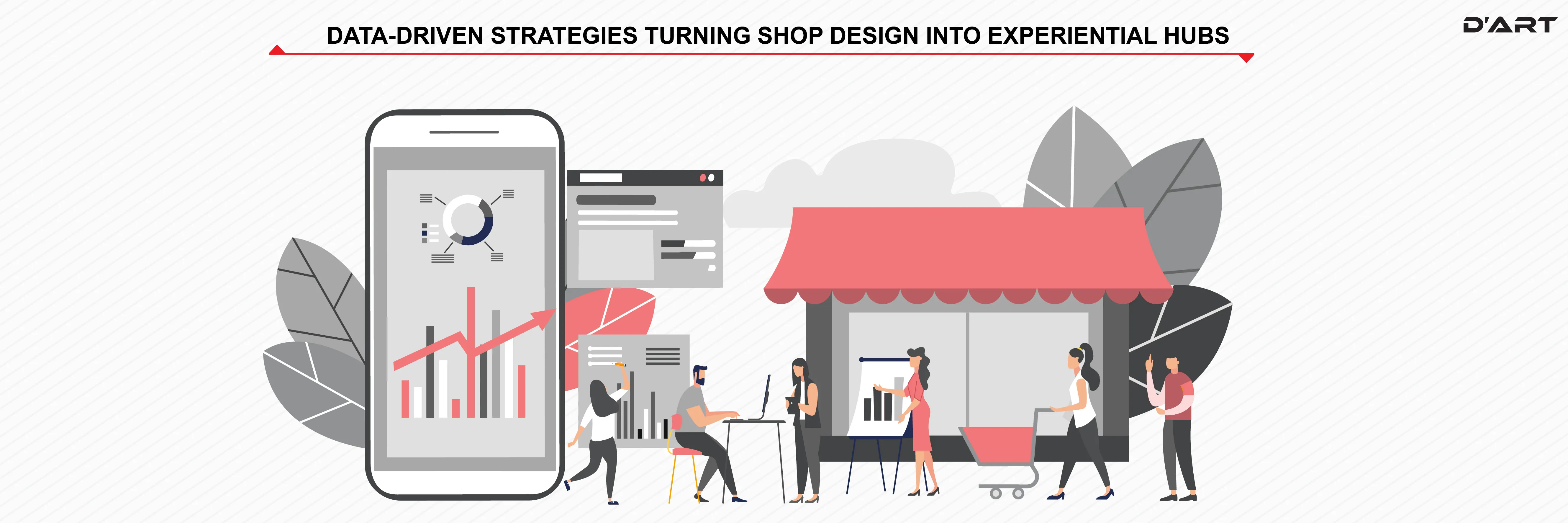DATA-DRIVEN STRATEGIES TURNING SHOP DESIGN INTO EXPERIENTIAL HUBS

HOW DATA IS BEING USED
Data is the new oil, shaping the retail industry. With everything being digital now, every course of action directly or indirectly can be used as data. Our comments, stories, likes, dislikes, searching, browsing, and viewing on digital platforms provide brands the opportunities to know about their user, shape their products, services, and spaces accordingly, and give the audience experience that makes them feel they have agency over these experiences.
Data is rich in as many opportunities as the brand can fathom and can also arm the brands with the power to improve and explore various unknown and untouched territories.
Since data is capable of mapping out customer behavior. It can also help predict the next big thing. But how data is being integrated into the design philosophy?
WHERE DOES DATA FIT INTO THE DESIGN?
Thoughts are a storm, unexpected. Creating a design is like creating new ideas in a petri dish. Design is a calculated effort with a precise aim. And thus, has components of both art and science.
“Design is not just what it looks like and feels like. Design is how it works.” –– Steve Jobs. When problems are solved systematically, the aim is to address a particular need. It's that laser focus that makes a design successful.
While the aesthetic comes after when something is designed, it is no less important. Design is problem-solving while aesthetics makes it relatable and eye-catching and helps lead the audience's attention to the desired spot. And once the audience is hooked. Design is the final sell and depends upon the audience that is going to use it.
Imagine shop interior design that neglects consumer needs in favor of aesthetics. It might look alluring at first but will fall flat when consumer needs are not met.
If the design is void of understanding of its user's needs, then it is useless and would be purely aesthetic and would be purposeless. It is often said that good design is invisible and the user doesn't even notice in presence. Only when a design fails to understand its users and gets materialized without any purpose or need in mind, does it get complicated? The collection of minute details and the understanding of the user would make a design successful.
And that's where big data comes in. Data has a big amount of information and valuable insights ready to be extracted. This large mine of data when converted into useful insights, helps the brand make informed decisions.
And these insights are the seed to build solutions that are incorporated into the design to make life easier for everyone involved.
Moreover, data gets collected from every useful touch point, and based on filtered information marketing campaigns, and strategies are formed.
Imagine data-driven recommendations leading to a 33% increase in sales for an e-commerce platform. The data is the shopper's information when they visit and browse the website or store including preferences, Wishlist, shopping history, etc. Through this data, it is predicted what the shopper is willing to buy. Similarly, some brands predict pregnancies by analyzing women's behavior when they engage with the website. The brand can give away personalized offers to stay ahead of its competition.
When the retailers have useful information about their customers they can know their target audience's preferences and shopping habits. And those insights can be used in designing better modes of customer brand interactions for max gain. Such as beacons, emit low-energy radio waves known as Bluetooth Low Energy signals. These signals are received by mobile devices within close physical proximity, which can be used to determine a location and trigger location-based actions. Through that action, readers can direct shoppers to a specific product or department. Furthermore, the brand can send a notification of a discount coupon when they pass a restaurant. This can also be used to predict how they'll navigate the store and the departments they'll visit.
Experiences that are personalized are better received by consumers today. Hence, by integrating the shop design with the online activities of the audience, the gap between the brand and the audience can be bridged and the bond strengthened.
As humans, we are driven by proof and data, which adds to the collection of past experiences, allowing us to adhere to and adapt our insights based on our past experiences.
Regardless of the space, field, or market. well-analyzed data can help brands make their presence stronger. Information collected about the target audience and how well it's analyzed determines how well the brand understands its positioning in the market.
And with the emphasis on transparency, in front of the audience and the brand. There is a tug of war going on between instinct and data. As experience and fast-paced trends go to war over how to steer the retail business. Should keep the environment cozy and down to earth or do you take your retail store into experience hub territory and see how far you can stretch?
Since the idea of innovation has taken hold of the daily market and the retail industry. What new can we do? Philosophy is on the rise and the minuscule level of data and insight that are available only makes the matter worse. So as the market changes some changes are inevitable.
Thus we should always remember that the purpose of data should be to bridge the gap and make the transition smoother between the roots of the brand when it was just a single store and the multifaceted experience center that gives their customer exactly what they desire in the way that they desire.